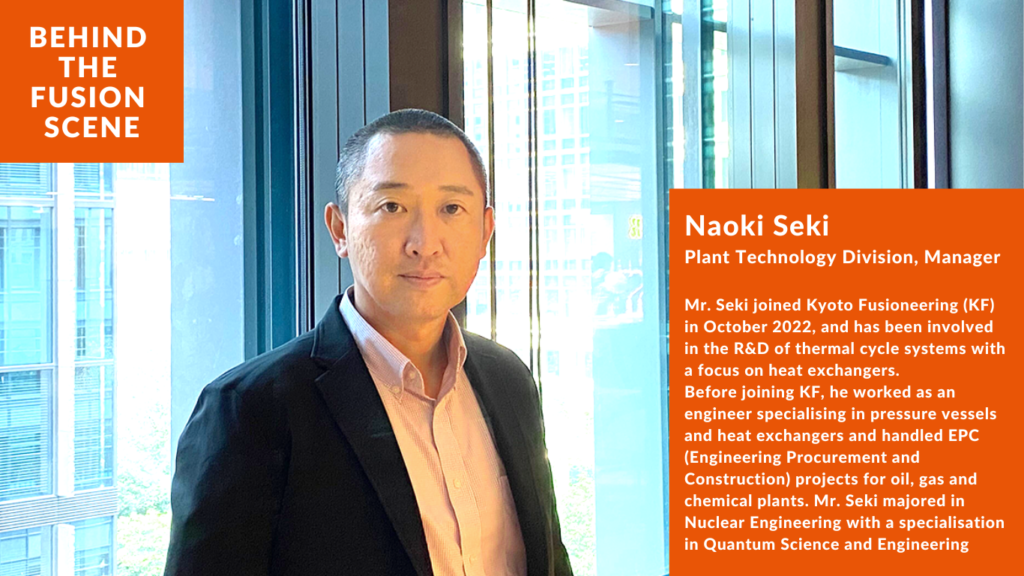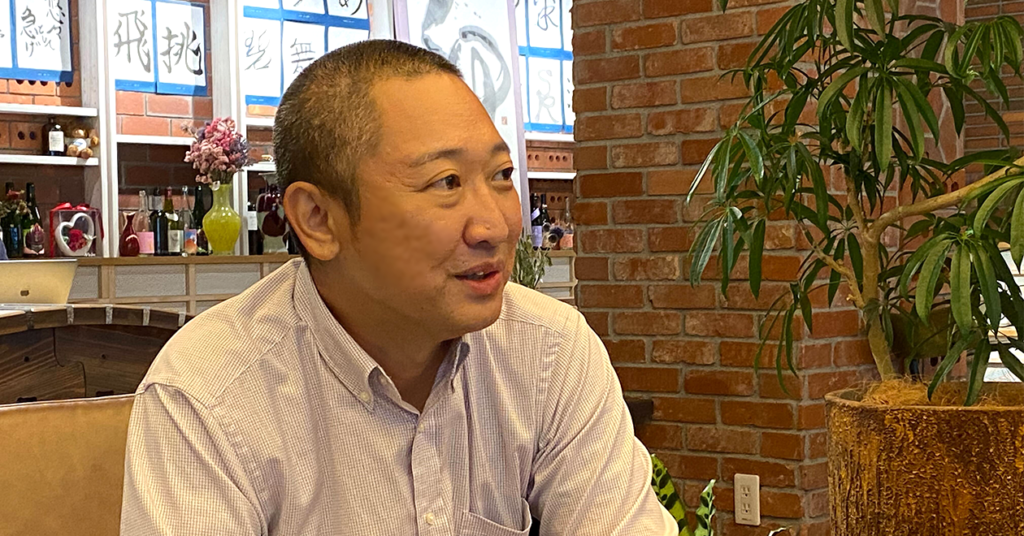
In a nutshell:
Ever since he was a child, Mr. Seki had been intrigued by the essence of things that caught his attention. He decided to major in Nuclear Engineering during his university years and delve into the micro-level research of materials and phenomena. After graduation, he joined a major engineering company, where he worked as an engineer specialising in pressure vessels and heat exchangers for oil and chemical plants. While he found fulfillment in his engineering career, he was captivated by the possibilities of practical fusion energy, a fascination that had developed during his university days. Fueled by the desire to contribute to the realisation of fusion energy, Mr. Seki made a career move to Kyoto Fusioneering Ltd. (KF) in 2022. Currently, he works as a heat exchanger engineer, leading the research and development of equipment for nuclear fusion reactors while also managing a team of professionals working towards completing the World-first Integrated Testing Facility for Fusion Power Plant Equipment called “UNITY.”
Could you please tell the reason you specialised in nuclear engineering at university?
Since I was a child, I loved exploring the intricacies of the phenomena that surrounded me. Whenever I came across interesting objects or machines, I would dismantle and modify them. For example, I wanted to know how to make a Mini 4WD car go faster, why a fast motor is fast, and which parts of the body to lighten to increase speed. My curiosity to understand why these phenomena occurred was strong even as a child.
With such a childhood, I decided to focus on quantum engineering in the nuclear engineering department at university because I wanted to research the elucidation of substances existing in the natural world and the explanation of phenomena from a more microscopic perspective. In the research lab, I was conducting studies on the molecular dynamics of a natural gas called methane hydrate known as “burning ice”. Specifically, I measured the movement of methane hydrate molecules and energy through the neutron non-elastic scattering experiment. By comparing and analyzing the simulation and experimental results, I found it fascinating to explore and discover phenomena as well as unknown ones.
What kind of work were you involved in at that time?
I was engaged in the engineering of pressure vessels used to store gases or liquids at pressures different from atmospheric one, as well as heat exchangers used to transfer heat between two or more fluids at different temperatures. My work included not only the design of facilities with a focus on simulations but also procuring parts from vendors and constructing facilities on-site.
Since it was a large enterprise, the scale of the projects was significant, and I had opportunities for overseas assignments in countries like Qatar and Malaysia. During my overseas assignment, I frequently collaborated with local colleagues and foreign members who had come to work temporarily. However, due to cultural differences and work perspectives, I faced challenges in management. Especially in the beginning, I was uncertain about whether I could create a well-functioning team that shared the same goals. Nevertheless, by communicating openly without any barriers and respecting each other’s values, we gradually began to feel a sense of cooperation within the team. It was gratifying to see the entire team working with high motivation, and hindsight is 20/20, I consider it a valuable experience in my career.
As I was responsible for overall project management, I experienced a wide range of tasks, including coordinating schedules with on-site workers and vendors, handling issues that arose, and elaborating alternative plans in case construction did not progress as per the design. Namely, there was significant pressure to complete the projects on schedule. There were many challenges in balancing the local situation and progress, but when I saw the facilities that I was involved in constructing successfully operating on a completely vacant lot, I felt a profound sense of achievement. Simultaneously, the frequent visits to the construction sites allowed me to learn the importance of incorporating practical considerations into the designs.
Overall, I gained valuable experiences as an engineer during this period.
What motivated you to dive into the world of fusion energy?
It was when I was a university student that I first heard about fusion energy. I was overwhelmed that it could produce an enormous amount of energy from a small amount of fuel compared to other chemical reactions. However, at that time, it still seemed like a “dream energy” that was far from realisation.
However, I never forgot about the fusion even after I started working. Then, I heard news by chance about the first fusion energy startup in Japan. As I saw the increasing possibilities of realising fusion energy, my desire to contribute the commercialising fusion power from a private company’s perspective grew stronger. When considering the option of changing careers, I grappled with the dilemma of whether I would bother my family due to the departure from a large and stable enterprise. However, fortunately, upon taking stock of my knowledge and past work experiences, I realized that the field I was venturing into would allow me to leverage my background in atomic physics, which I had studied at university, and the engineering knowledge I had deepened in my previous job. Additionally, my strong desire to quickly acquire expertise in the field of fusion energy drove me significantly to pursue this path and I also got the unwavering support of my family.

What projects are you currently working on at KF?
I am part of the Plant Tech (fusion reactor peripheral equipment) team and am involved in the research and development of that kind of equipment that is necessary to extract heat from the energy generated by fusion reactions and utilise it for power generation.
Currently, our focus is on the construction of the “UNITY,” the world’ very first integrated test facility for fusion power plant equipment that aims to demonstrate fusion power generation. As an engineer responsible for heat exchangers, I am involved in the design and development of systems that transfer heat from the high-temperature liquid metal, which exceeds 1000°C, to adjacent low-temperature fluids.
What did you feel when you jumped the fusion energy industry and KF, a startup company?
Regarding my main job, I did not feel a significant gap. This is because many of the tasks at KF were focused on research and development in the pre-industrialisation stage, and I anticipated that.
Additionally, the role I took on was in a field like my previous job, allowing me to directly apply my past experiences. For example, the heat exchanger we are currently working on applies innovative technology called “SiC/SiC composite,” which involves materials containing silicon and carbon cultivated over many years at Kyoto University. Certainly, it differs in type from the heat exchangers I dealt with in my previous job, but I can leverage my mechanical engineering knowledge acquired from my previous job when it comes to understanding the mechanism and structure of the heat exchanger, as well as material selection considering equipment corrosion and durability.
On the other hand, there are remarks that I noticed after I joined KF, a startup. For instance, collaboration with external parties. Since KF does not have its own factories or research facilities yet, we conduct various projects in collaboration with different companies. By working together with external researchers and engineers on research and development, I get the opportunity to receive insights from different perspectives, which is a valuable learning experience. It is quite stimulating to encounter ways of thinking that we would not have produced on our own.
Moreover, when I propose something “I want to take on this challenge because I believe it’s the right thing to do,” in a large corporation, there are often numerous internal hurdles that need to be overcome before such proposals can be realized. In some cases, achieving these proposals can be quite difficult. Working at KF provides a unique sense of fulfillment and enjoyment as we actively engage in challenges. Each team member’s dedication and passion play a crucial role in propelling the company forward. We share a common vision and purpose, making the journey towards fusion energy realisation even more thrilling. In this dynamic startup environment, I find great satisfaction and pleasure in the pursuit of our shared goal, contributing to the advancement of fusion energy in a field yet to be explored by previous generations.
In particular, I have realised even right after joining KF, that every employee, including CEO Mr. Nagao, possesses a passionate commitment to the goal of achieving fusion energy at an early stage. This level of enthusiasm has been evident from the very beginning, and I believe that such high levels of dedication are one of the strengths of a startup.
What do you believe KF’s technical team needs to focus on to advance towards the realization of fusion energy?
Moving forward, I strongly believe that we should put even more effort into properly organising and sharing each team member’s areas of expertise within the team.
With the business expanding, we have new members joining us one after another. Most of them are experienced professionals who have accumulated specific expertise in their respective fields through their previous careers. In research and development, it is crucial to organise the know-how possessed by everyone within the team. We extract the necessary knowledge and combine it effectively to derive the optimal solutions needed to successfully complete our projects.
By effectively leveraging the diverse expertise of our team members, we can tackle challenges more efficiently and enhance our ability to innovate in the pursuit of fusion energy realisation. The synergy resulting from shared knowledge and collaboration within the team will undoubtedly accelerate our progress towards our shared goals. As we continue to grow, fostering a culture of knowledge exchange and teamwork will be key to our success.
What would you like to achieve with KF?
First and foremost, my goal is to complete the construction of “UNITY,” which is currently in its construction phase. In the field of manufacturing, a single project involves multiple essential processes such as design, procurement, construction, and safety management. It’s natural for such projects to take several years to reach completion. Similarly, “UNITY” has been moving forward with a timeline of several years from its conceptualisation to its construction. While there may be unforeseen challenges along the way, the Plant Tech team, along with the entire company, is tirelessly working towards this goal.
In the medium to long term, my aspiration is to be involved in the construction of Japan’s first nuclear fusion plant. Indeed, deep within my heart, I always carry the desire to contribute to “a world where people can live safely, securely, and happily”. I want to continue channeling this passion into my daily efforts towards the early realisation of fusion energy.
■Job Opportunities
■Previous Behind the Fusion Scene




